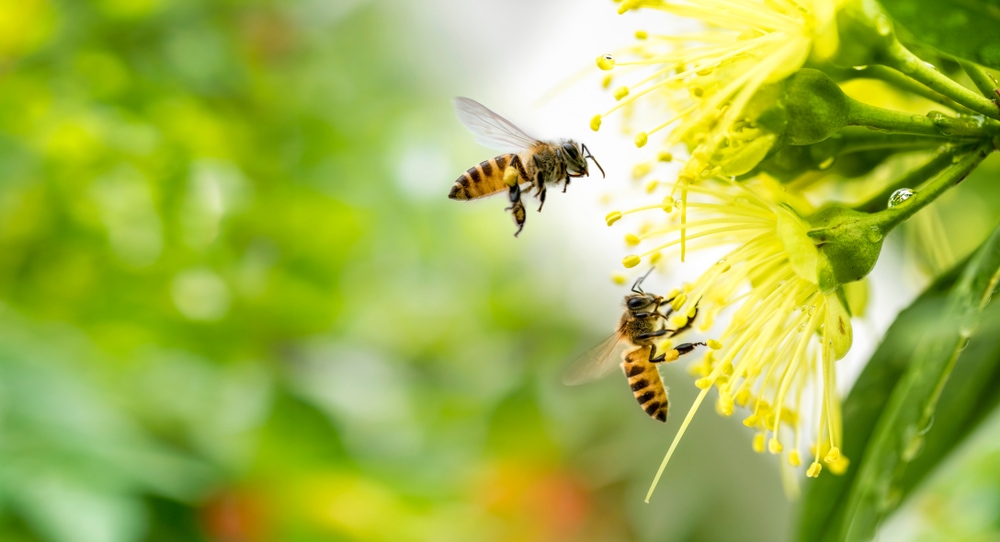
With over 20,000 known bee (superfamily Apoidea) species in the world, it’s impossible to know everything about each one. They come in as many sizes, shapes, and colors as the flowers they pollinate. Some of them are smaller than a grain of rice and there are many species of bees that have yet to be named or described.
They are pollinators that help facilitate the reproduction of 90% of the world’s flowering plants. If you’re a gardener, the bees say, “you’re welcome.” This also makes them vital to creating and maintaining the habitats and ecosystems that many other animals rely on for food and shelter.
Before we journey into the world of bees, it helps to know the fundamentals of what they are and what makes them truly special.
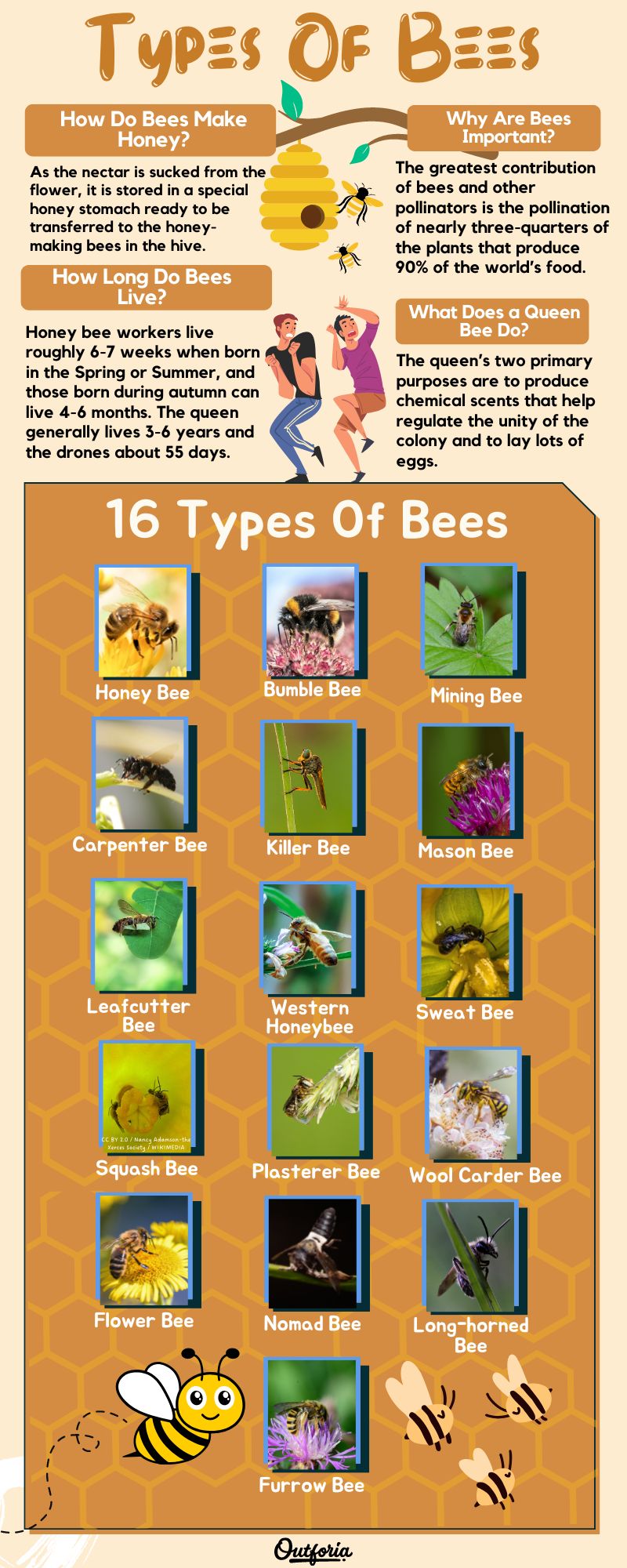
SHARE THIS IMAGE ON YOUR SITE
<a href="https://outforia.com/types-of-bees/"><img style="width:100%;" src="https://outforia.com/wp-content/uploads/2022/12/types-of-bees-infographics.jpg"></a><br>Types Of Bees <a href="https://outforia.com">Outforia</a>Bee Facts
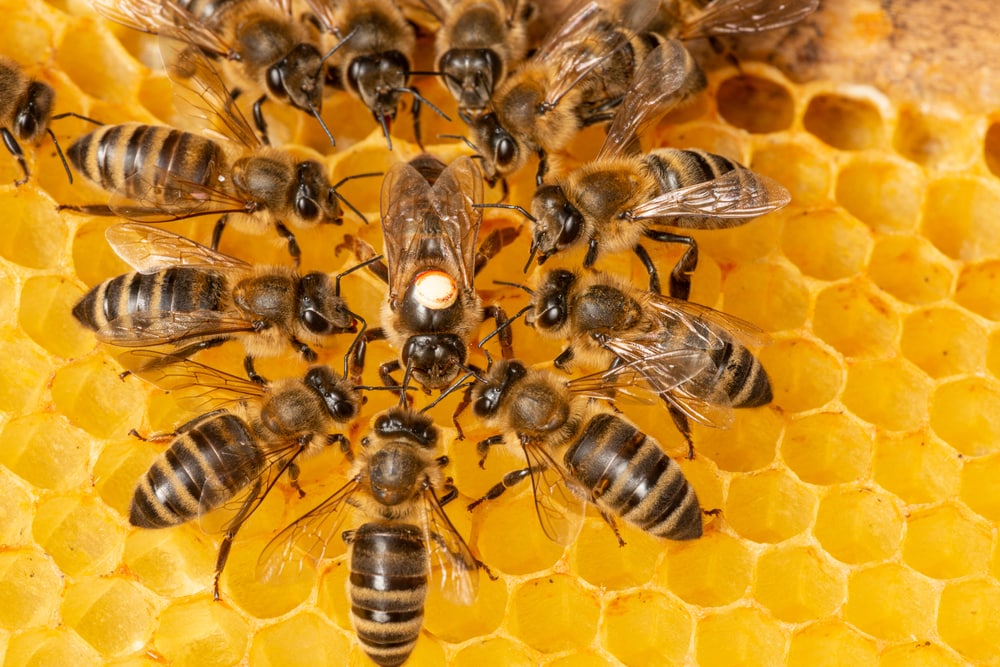
Pollinator Definition
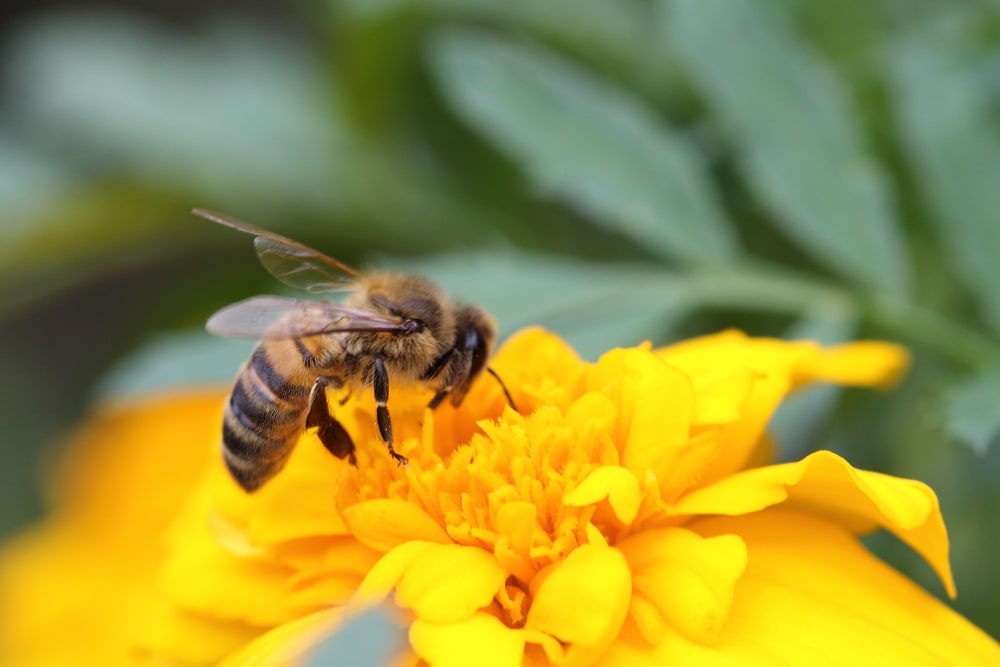
A pollinator is anything that helps carry pollen from the male part of the flower (stamen) to the female part of the same or another flower (stigma). The movement of pollen must occur for the plant to become fertilized and produce fruits, seeds, and young plants.
Some plants are self-pollinating, while others may be fertilized by pollen carried by wind or water. Still, other flowers are pollinated by insects and animals, such as wasps, moths, butterflies, flies, and bees.
Insects visit flowers in search of food, shelter, nest-building materials, and sometimes even mates. Some pollinators, including many bee species, intentionally collect pollen. Pollen sticks on their bodies while they are drinking or feeding on nectar in the flower blooms and is transported unknowingly from flower to flower resulting in pollination.
Some species of bee employ a technique called sonication, or buzz pollination when they harvest pollen. During sonication, the bee rapidly vibrates its flight muscles while attached to the flower. This loosens the pollen, which makes it easier to collect.
Bee Classification

Bees (Anthophila) are classified as insects (Insecta). Insects are small arthropod animals that have six legs and generally one or two pairs of wings. There are over 20,000 known bee species in the world.
Bee Life Cycle
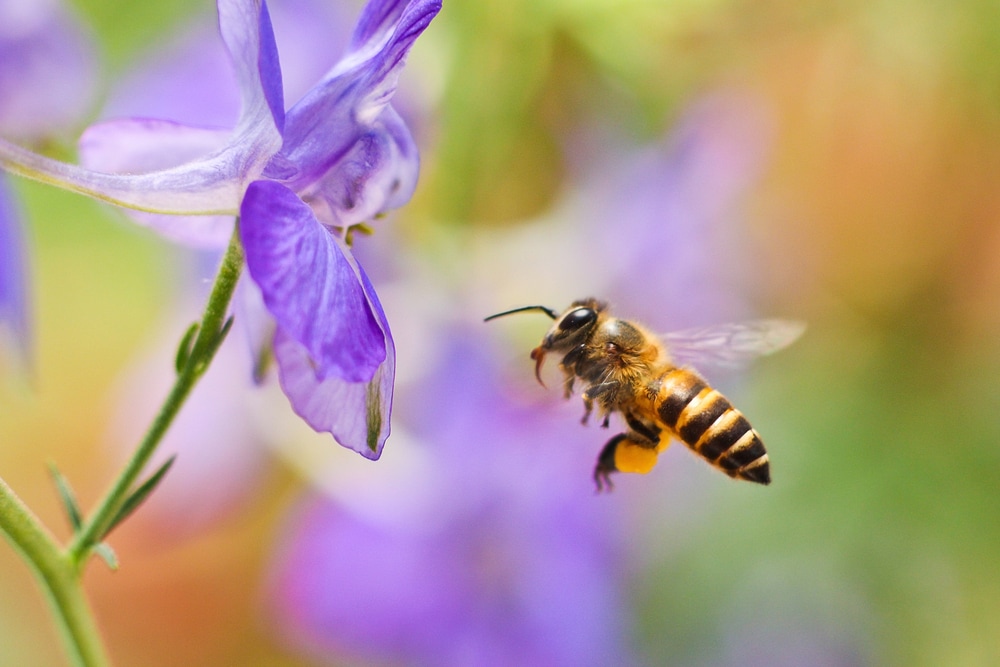
The life cycle of a bee begins when an established colony’s queen lays up to 2,000 eggs per day throughout the spring. She lays her eggs within individual cells inside a honeycomb. Queens store more than 5 million sperm cells inside their bodies, enabling them to lay eggs throughout their life after only one mating flight.
When the eggs hatch, those that were fertilized become female worker bees, while the unfertilized eggs become male bees. Bee eggs measure approximately 1 mm long. After three days, the eggs hatch into larvae, which have no eyes, wings, legs, or antennae.
Around six days after hatching as larvae, they reach the third stage, spin cocoons, and eventually hatch into adult bees after another seven to 10 days. Like ants, newly hatched bees have different designated responsibilities until they grow old.
You May Also Like: These 28 Cutest Types of Bats Will Change Your Negative Perception of Them with Photos, Infographics, Facts, and more!
16 Popular Types of Bees with Pictures
1. Honey Bee

There are seven well-known subspecies of Honey bees (tribe Apini). They belong to the genus Apisare and include all bees that make honey. Honey bees are social insects and live together in nests or hives. Let’s learn about them individually.
1.1 Black Dwarf Honey Bee (Apis andreniformis)
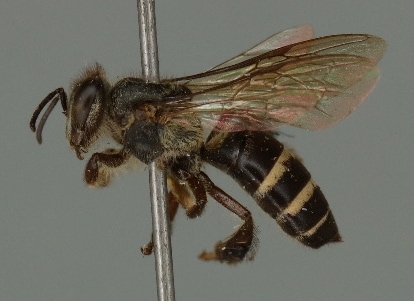
The smallest of all species of honey bees, the black dwarf honeybee is between 6.5 mm and 9.5-10 mm. It’s a relatively rare species of honey bee whose native habitat is the tropical and subtropical regions of Southeast Asia.
We can distinguish this bee from other Apis species by its dark black coloration. It makes them the darkest of their genus. Its first two abdominal segments are black and it’s scutellum (thorax) is yellow.
While scientists studied the black dwarf honey bee they concluded that this honey bee is unable to recognize its own species and nestmates. They deducted this inability when observing the queens joining a colony without facing aggression upon their initial arrival.
The black dwarf honey bee is a non-domesticated provider of some commercial products like honey, wax, royal jelly, and bee venoms. They are important pollinating agents in their region of occurrence.
1.2 Cavity Nesting Asian Honeybee (Apis cerana)
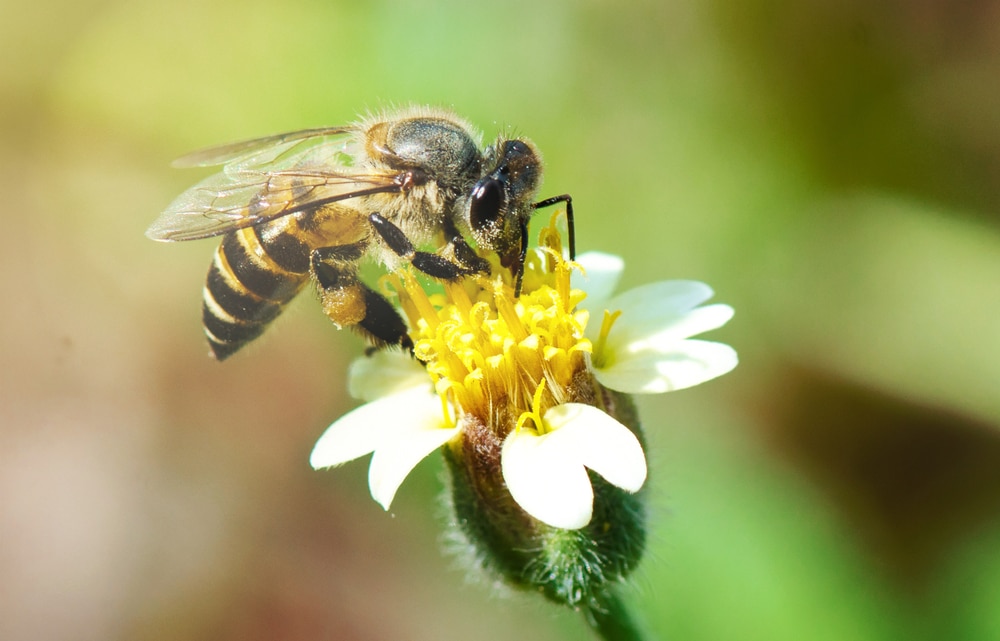
Known as the eastern honey bee or the Asiatic honey bee, the cavity nesting Asian honey bee is native to southern, southeastern, and eastern Asia. Its colonies are relatively small, with only around 6,000 to 7,000 workers.
Their size is somewhat smaller than the western honey bee, They also have more visible abdominal stripes. Adult worker bees are black, with four yellow abdominal stripes. The cavity nesting Asian honey bee is primarily found in the wild but is one of the few domesticated bees.
When this species’ hive is invaded by other insects, they surround the intruder and vibrate their flight muscles until the temperature is raised to 117 °F (47 °C), heating it to death, but keeping the temperature still under their lethal limit.
1.3 Giant Honeybee (Apis dorsata)
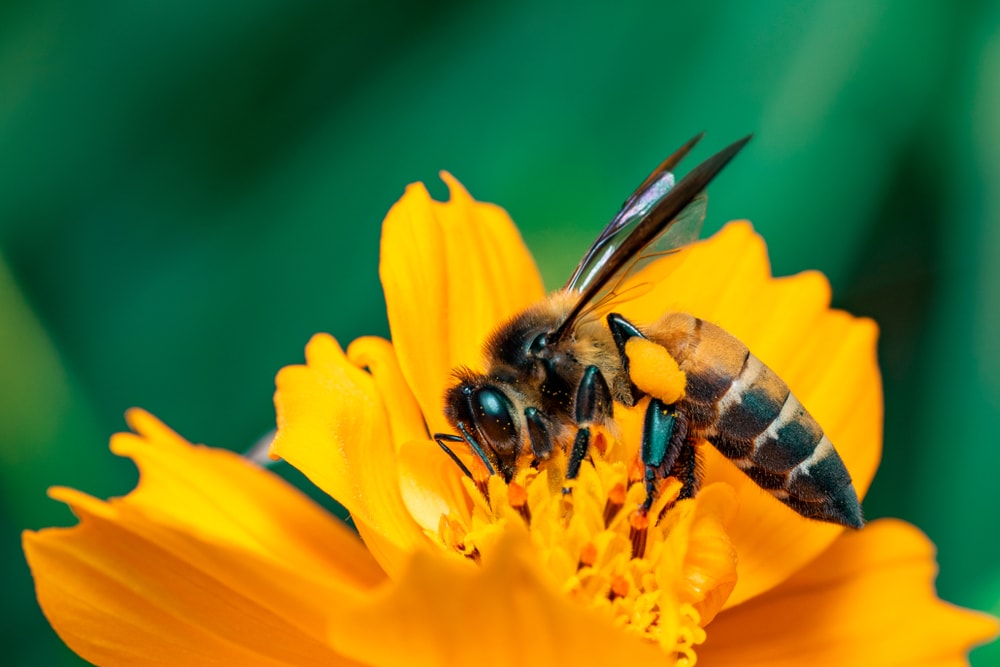
The giant honey bee is non-domesticated. Many crops in southern Asia depend on this species. These crops include cotton, mango, coconut, coffee, pepper, star fruit, and macadamia.
It has similar colors to the western honey bee, presenting golden, black, and pale bands on the abdomen and with a hairy thorax. The length of a worker bee is around 0.7–0.8 in.
The giant honey bee builds open curtain-like nests that hang from tree branches, and sometimes from buildings. Its large body size allows these bees to have a greater flight and foraging range than those of other honey bee species.
These bees use a defense known as shimmering, involving a display of waves that move across the surface of the nest in a fraction of a second as the bees raise their abdomens in sequential order. The visual display of shimmering is thought to intimidate potential threats such as predatory wasps, birds, and mammals.
1.4 Koschevnikov’s Honeybee (Apis koschevnikovi)
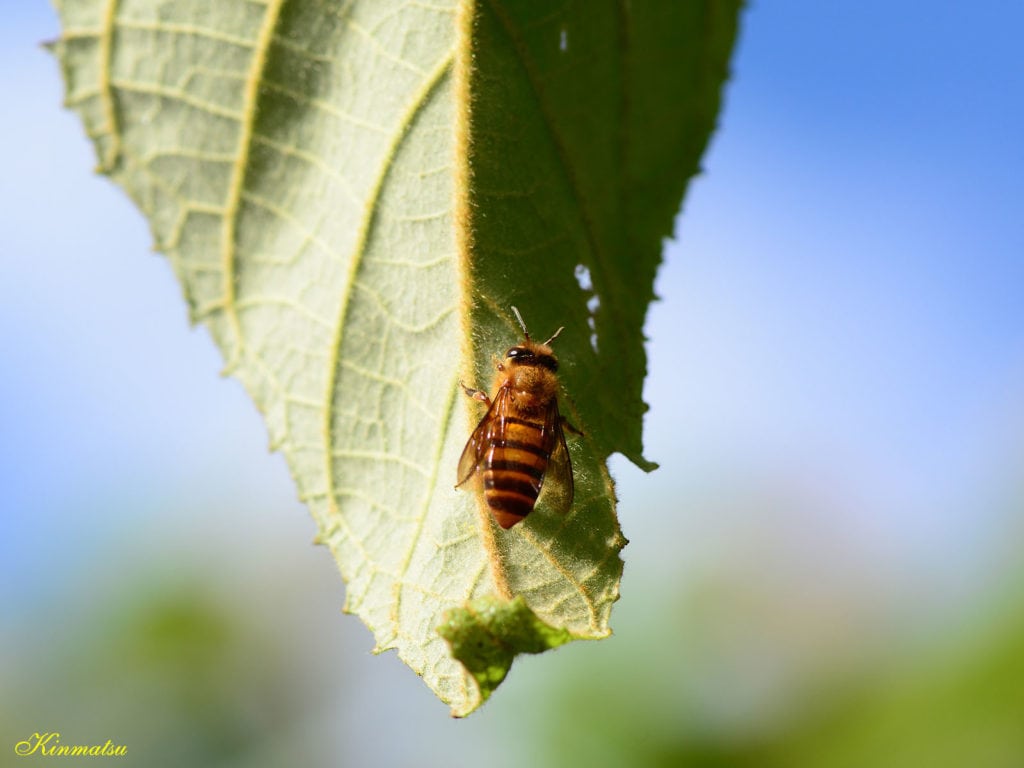
The Koschevnikov’s honey bee also spelled Koschevnikovi honey bee and known as the red bee of Sabah, is a medium-sized, reddish, non-domesticated rare bee.
Koschevnikov’s honey bee has red coloring on its metasoma (hind region) and legs. This is true only in Sabah State, Borneo, Malaysia. On the Malay Peninsula and Sumatra, Indonesia it has a dark, coppery color.
Its habitat is limited to the tropical evergreen forests of the Malay Peninsula, Borneo, and Sumatra. Worker bees have a moderate body size with a forewing length between 7.5–9 mm.
1.5 Philippine Honeybee (Apis nigrocincta)
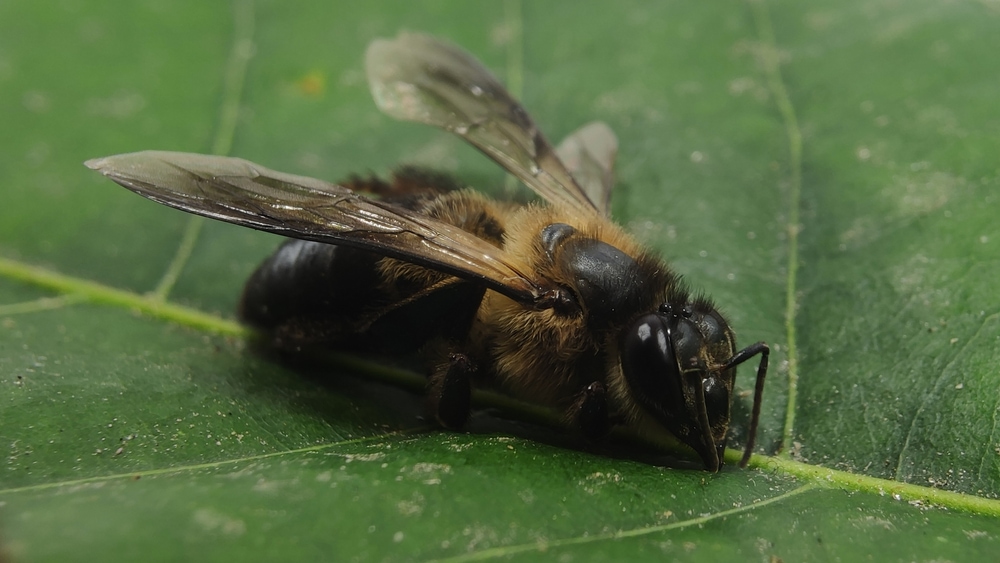
The Philippine honey bee is a rare, cavity-nesting, non-domesticated, medium-sized bee with red tones. The species has rust-colored scapes, legs, and clypeus, with reddish-tan hair color that covers most of the body.
Little is known about this species. In Sulawesi, most of the colonies of this honey bee are found at elevations above 1,300 feet (396 meters) above sea level. The bees build medium-sized cavity nests with multiple combs that are nearly halfway between each other. The nesting sites are close to the ground.
Two types of combs are found with the smaller being for the workers and the larger ones for the drones. Cells for the queen are found towards the lower edges of the combs. Scientists found this exotic species on Mindanao Island, Philippines, and Sulawesi, Indonesia.
1.6 Red Dwarf Honeybee (Apis florea)
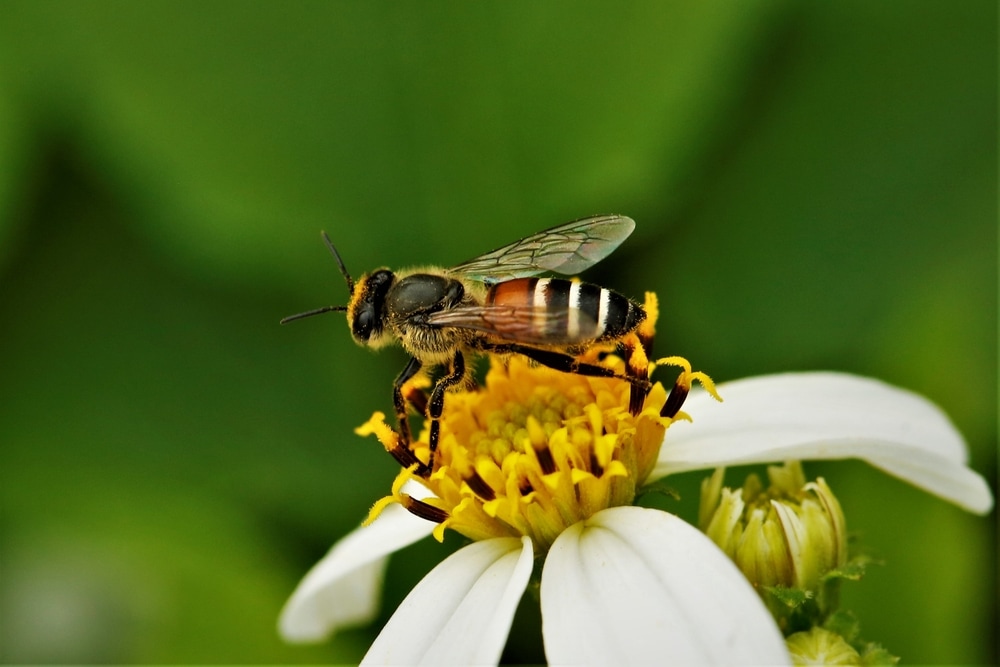
The non-domesticated red dwarf honey bee is named due to its small size, typically 7–10 mm in body length, and its overall coloration is red-brown. Old workers always have a red first abdomen and light whitish hair covering their thorax and legs. Younger workers are paler in color. Their stings are often not capable of penetrating human skin.
A brilliant defense behavior of this species, against their predominant predator, the O. smaragdina weaver ant, is its ability to produce and deposit sticky barriers to obstruct their enemy’s path.
The guard bees take cover at this sticky zone and start to alert other bees using specific hissing sounds to prevent full-blown raids by the ants. Over time, more bees are recruited to contribute to this sticky zone barrier which reinforces their defense
1.7 Rock Honeybee (Apis laboriosa)
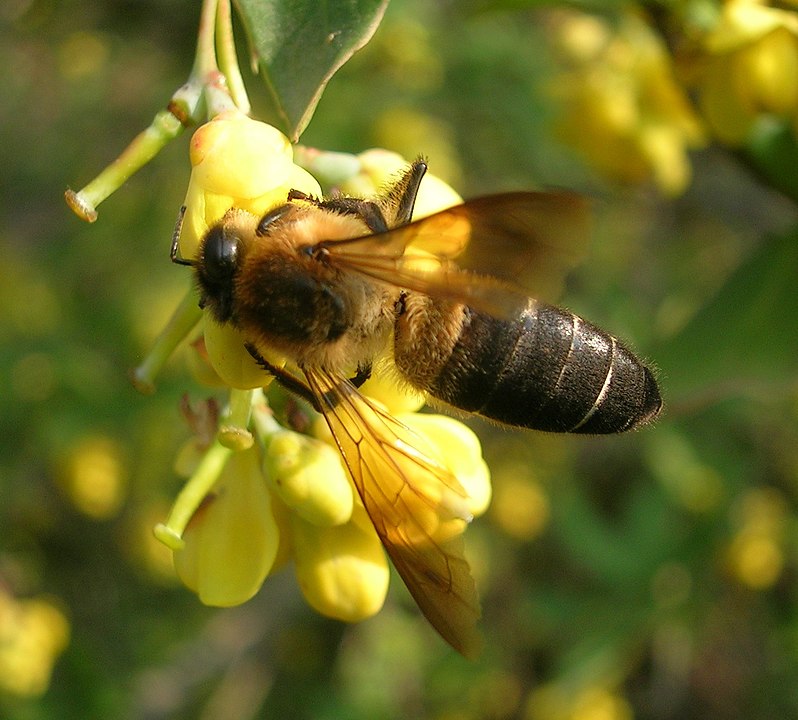
Limited to the Himalayas, the rock honey bee is the world’s largest honey bee and is also called the Himalayan giant honey bee. Adults can measure up to 1.2 inches in length and are brown-black.
It is another rare honey bee that is non-domesticated, considered a true giant bee, and produces what has been called “mad honey.”
Rock honey bees are the only bees producing the famous red honey, known for having an intoxicating effect and medicinal value. Those qualities stem from grayanotoxin present in the white rhododendrons (Rhododendron spp) nectar, which bees collect to make the honey.
2. Bumble Bee (Tribe Bombini)
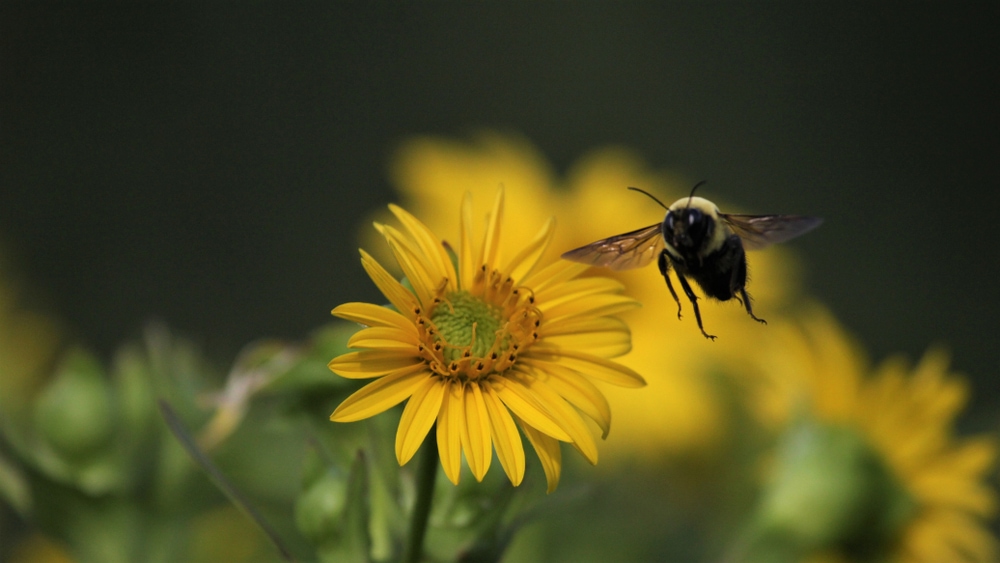
The bumblebee (also Bombus) is a tiny bee distinguishable by its round body and soft hair called pile. While bumblebees are social insects and not known to start an unprovoked attack, they are ferocious defenders when their nest is invaded and are known to chase invaders relentlessly over a long distance.
They are absent from most of Africa and the lowlands of India and have been introduced to Australia and New Zealand to aid in the pollination of various flowering plants. About 19 species of Bombus and six species of Psithyrus occur in Great Britain. About 50 species of Bombus, as well as some Psithyrus species, are found in North America.
Bumble bees average about 0.6 to 1 inch in length and are usually black with broad yellow or orange bands. They often nest in the ground, commonly in deserted bird or mouse nests. Bombus species are social bees.
3. Mining Bee (Anthophora Abrupta)
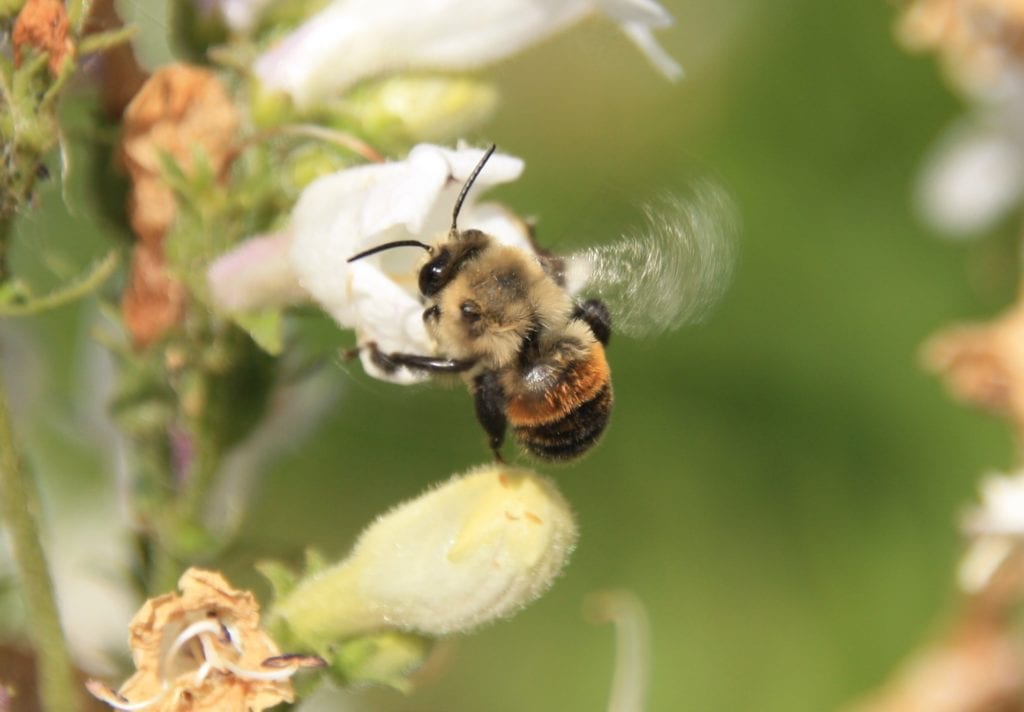
The miner bee is a fairly small bee, usually dark-colored, and often banded. The degree of fuzziness or hairiness varies among species. They have dense bristles (scopae) at the bases of the legs and the shin-like sections (tibias) of the legs, as well as by certain creases and grooves on the face and head and by unique wing vein patterns.
Mining bees vary greatly in size, from nearly an inch long to extremely tiny – those from the genus Perdita can be smaller than 0.1 inches and is one of the smallest bees in the world.
They might easily be mistaken as small honey bees or wasps, but they are non-aggressive solitary bees that typically do not sting. It ranges from Texas to Florida, stretching up the East Coast to Canada. Miner bees are most well-known and studied due to their complex nesting behavior.
4. Carpenter Bee (Xylocopa)
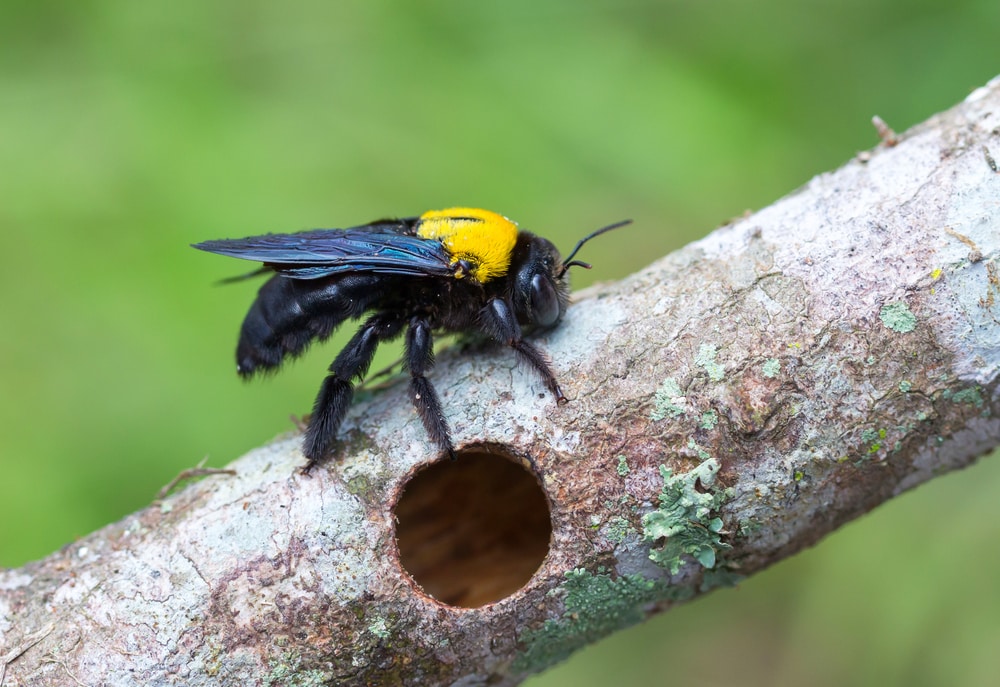
Carpenter bees make their nest by chewing tunnels into wood. You can find these woodworkers in southeastern Virginia down the East coast of the U.S. to Florida, west to Texas, and south to Guatemala.
Carpenter bees are solitary bees. They build nests just for themselves and only feed their own young. Carpenter bee stingers are not barbed, so they can sting over and over again. Their average length is one inch with blue-black coloring with an oval shape.
5. Killer Bee (Apis mellifera scutellata Lepeletier)
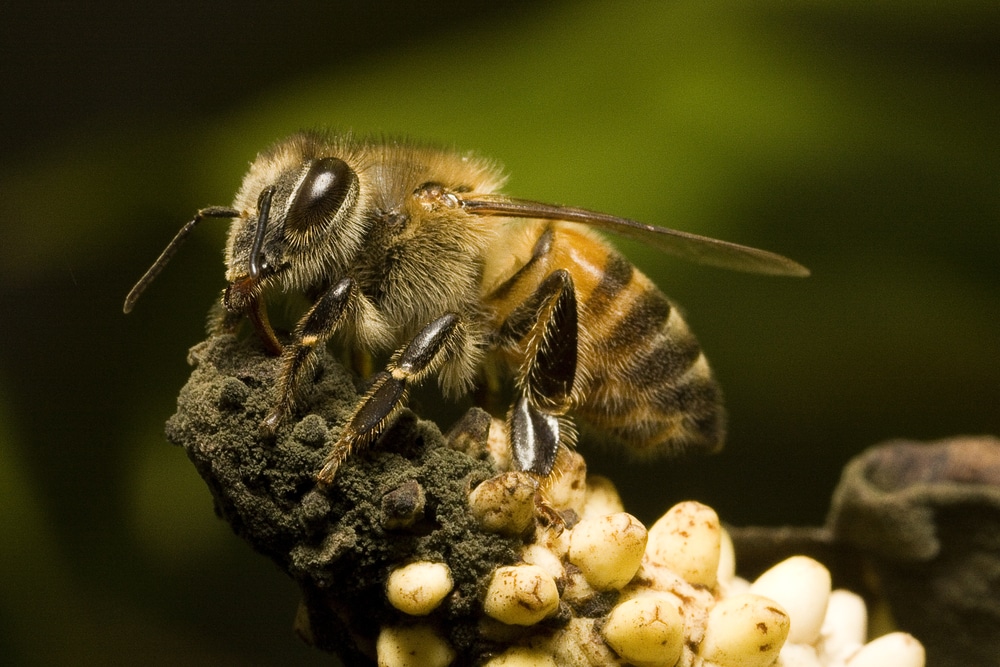
Killer bees or Africanized bees look a lot like regular honey bees, but they have different wing measurements. Africanized bees live in South America and the Western and Southern United States.
Though they are called “killer” bees, their venom is no more dangerous than regular honey bees. However, these bees tend to attack in larger numbers, which poses a greater danger to humans, especially those who are allergic to bee stings.
This species tends to be ½ an inch in length with golden-yellow coloring and darker bands of brown. Africanized bees are found in southern California, southern Nevada, Arizona, Texas, New Mexico, Oklahoma, western Louisiana, southern Arkansas, and central and southern Florida.
6. Mason Bee (Osmia)
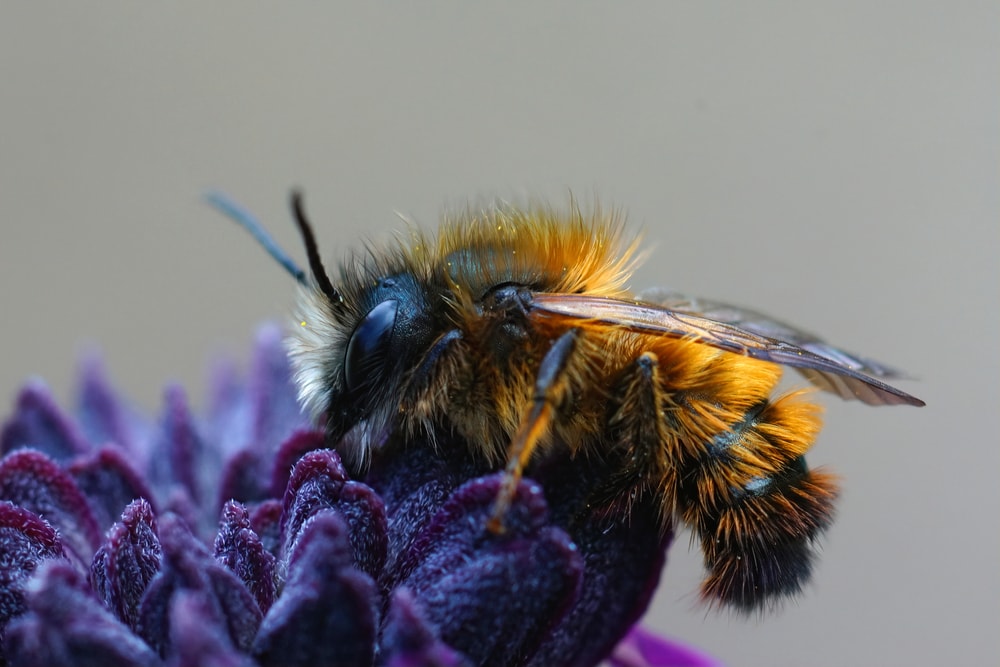
Mason bees tend not to sting because they are not social bees and do not have a hive or queen to protect. They measure between ¼ to ½ inches, covered in fuzz. Most North American species are metallic blue or green.
They use their large scissor-like jaws to gather mud, pulp, and leaves to construct nests. Mason bees do not make honey. They eat pollen and nectar throughout their lives as they forage.
There is no need to create stores of food as the adult bees die before the weather gets cold and the species overwinters as pupae. The pupae will emerge when the weather warms in the spring.
7. Leafcutter Bee (Megachilidae)
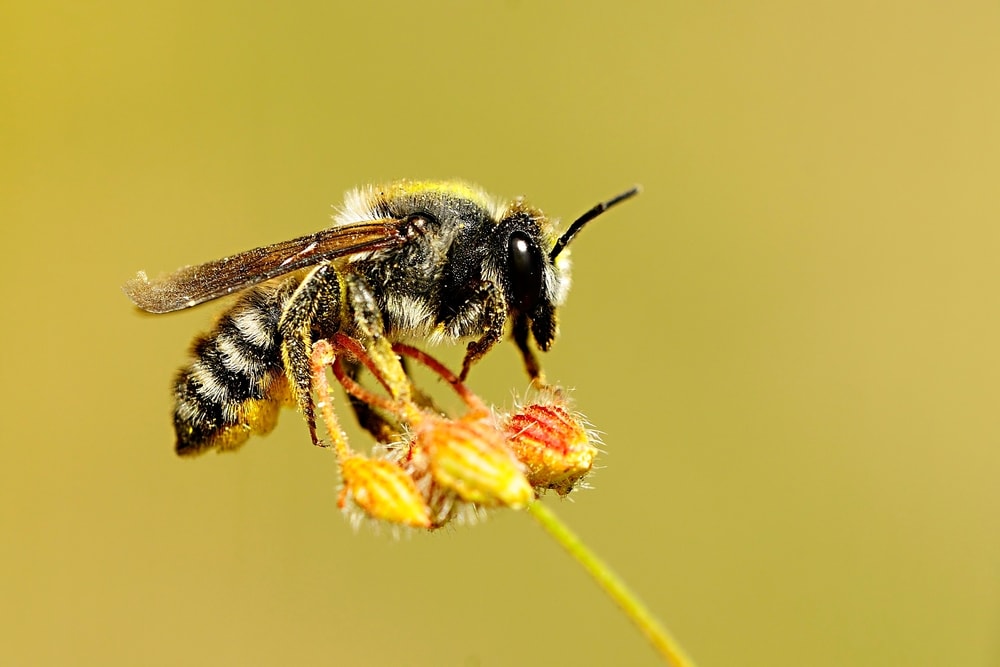
Leafcutter bees cut segments of leaf or petal with their jaws. They return this to the site of their nest and use it for constructing their egg cells. Some species are opportunists and will take advantage of man-made crevices, making them a welcome visitor for bee houses in gardens.
They range from 5 mm to 24 mm and have stout-bodied figures. They are black with white hairs covering the thorax and the bottom of the abdomen. Many species have large heads with massive jaws. Leafcutting bees are found throughout the world and are common in North America. In Florida, there are approximately 63 different species.
8. Western Honeybee (Apis mellifera)
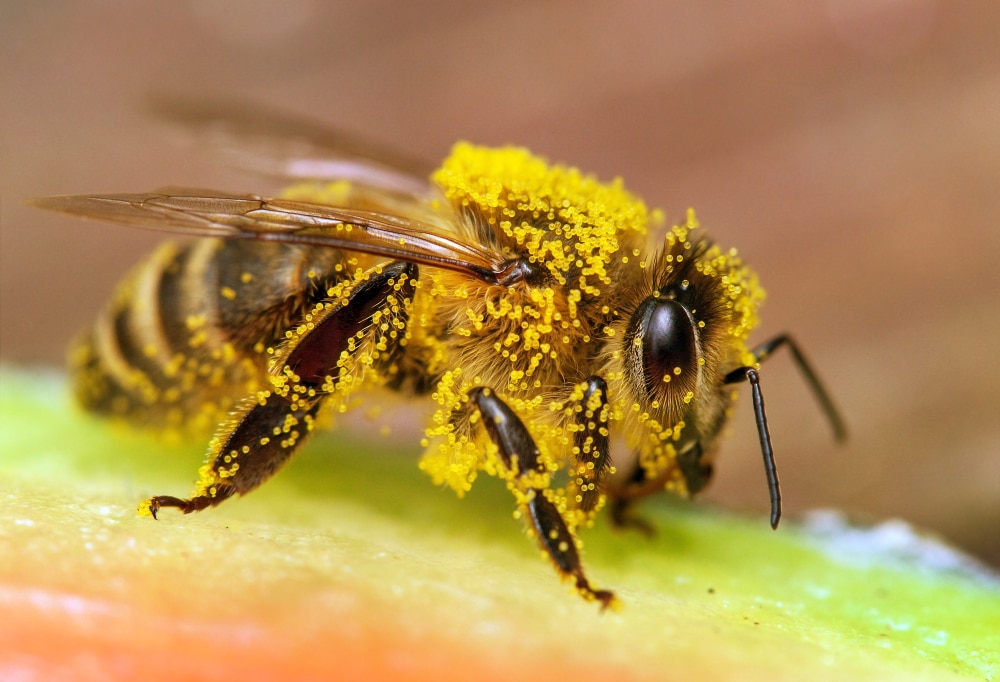
The western honey bee is also known as the European honey bee and is the most common species worldwide. It’s very popular among beekeepers for its honey production capabilities. Generally, they are reddish-brown with black bands and orange-yellow rings on the abdomen. They have hair on the thorax and less hair on the abdomen.
There are two classes of females, sterile workers are smaller (adults 10-15 mm long), fertile queens are larger (18-20 mm). Males are 15-17 mm long at maturity. Though smaller, workers have longer wings than drones.
This species is native to Europe, western Asia, and Africa. Human introduction of Apis mellifera to other continents started in the 17th century, and now they are found all around the world, including east Asia, Australia, and North and South America.
9. Sweat Bee (Halictidae)
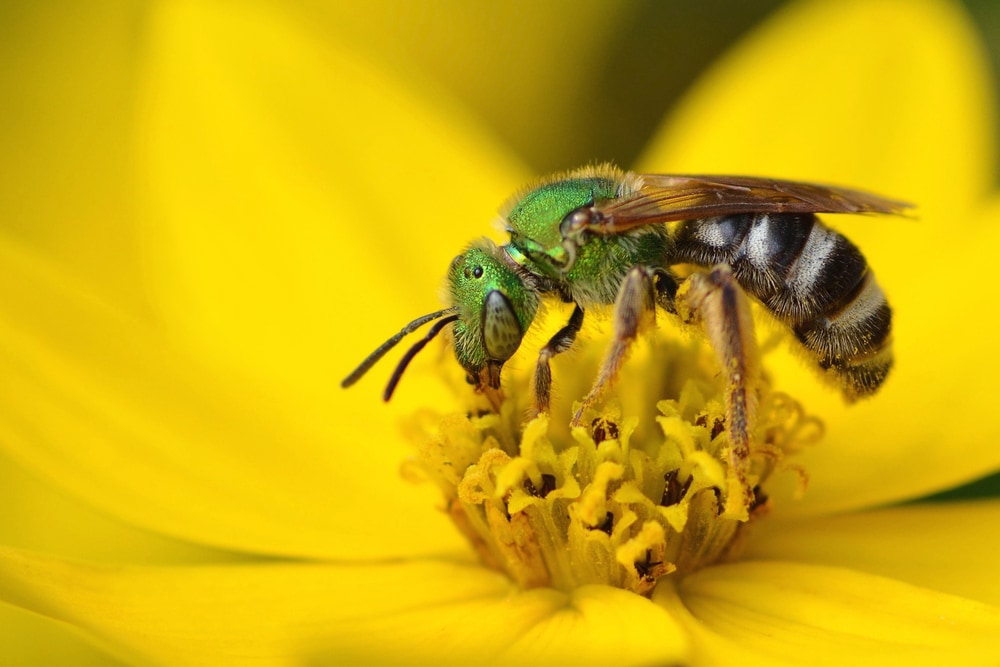
Sweat bees have short tongues, which come in handy for lapping up human sweat, which has earned them their name. They are the second-largest family of bees with nearly 4,500 species, all varying greatly in appearance. Some are metallic and others non-metallic in color.
They measure from 4 to 15 millimeters, about the size of a black fly, and range from fully colored to bright metallic hues. Except for honey bees, they are more abundant than most bees. Sweat bees are found worldwide but are plentiful in temperate regions.
Halictids display the most diverse social behavior as species can be solitary, communal, semi-social, or eusocial. Some species exhibit solitary or eusocial behavior depending on the time of year, geographic location, and altitude.
10. Squash Bee (Peponapis pruinosa)
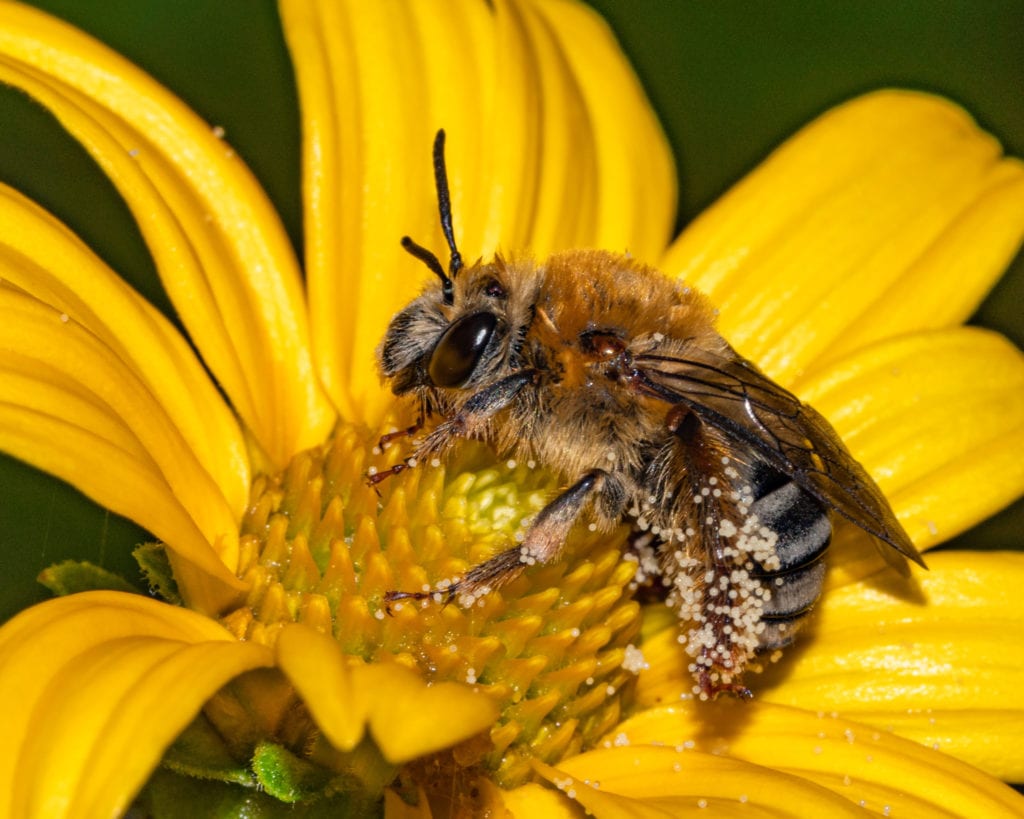
Squash bees have evolved to be specialists in the pollination of squash, zucchini, pumpkins, and many gourds. They are one of the few bees that fly pre-dawn. Their primary flight times last until mid-morning, and they will fly again near dusk when squash and melon flowers open.
You can find these gourd foragers from Quebec southward into Mexico, wherever squashes are grown. Squash bees are non-social but sometimes gregarious ground-nesters. Every female digs her own nest.
This bee is 11 to 14 millimeters long and 4 to 5.5 millimeters wide at the abdomen. It is black with whitish bands on the abdomen and it is coated in yellowish hairs.
11. Plasterer Bee (Colletidae)
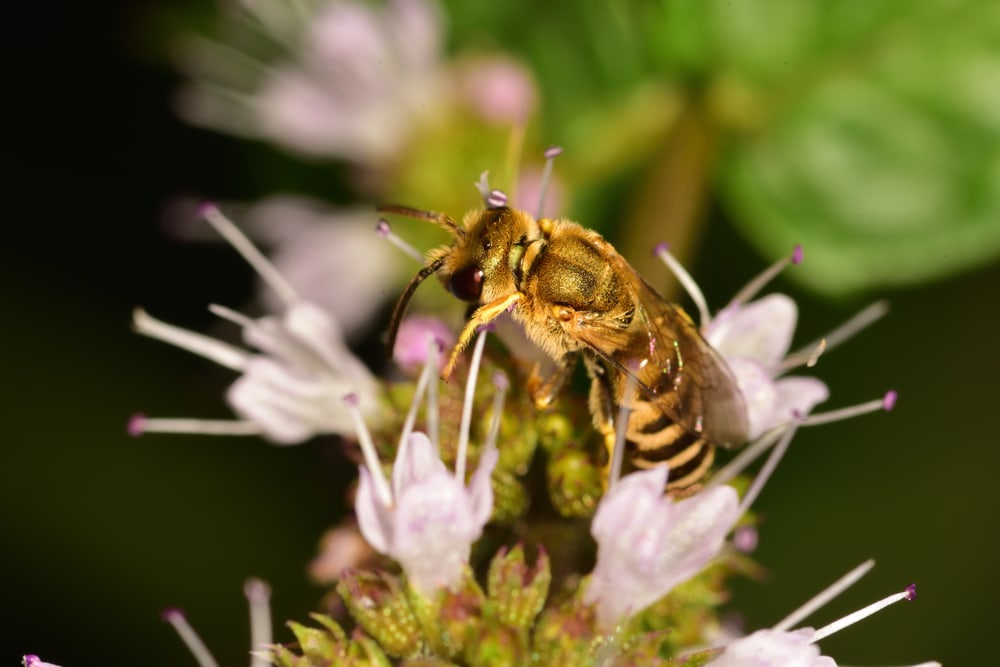
Also known as cellophane bees, plasterer bees are medium-sized bees, with females ranging from around 6.5-11mm species, and males slightly smaller from about 5.5mm-10.5mm, depending on the species.
They are moderately hairy, slender bees. These bees have very hairy heads and thorax. They have pale bands of hair on their abdomen. It’s a widespread genus with approximately 90 species in North America and 31 species from California. They range as far north as Alaska.
These bees make a waterproof, fungus-resistant substance that’s silky cellophane that they use to glue and line the walls of their nest cells, and which they apply with their short, forked tongues.
12. Wool Carder Bee (Anthidium manicatum)
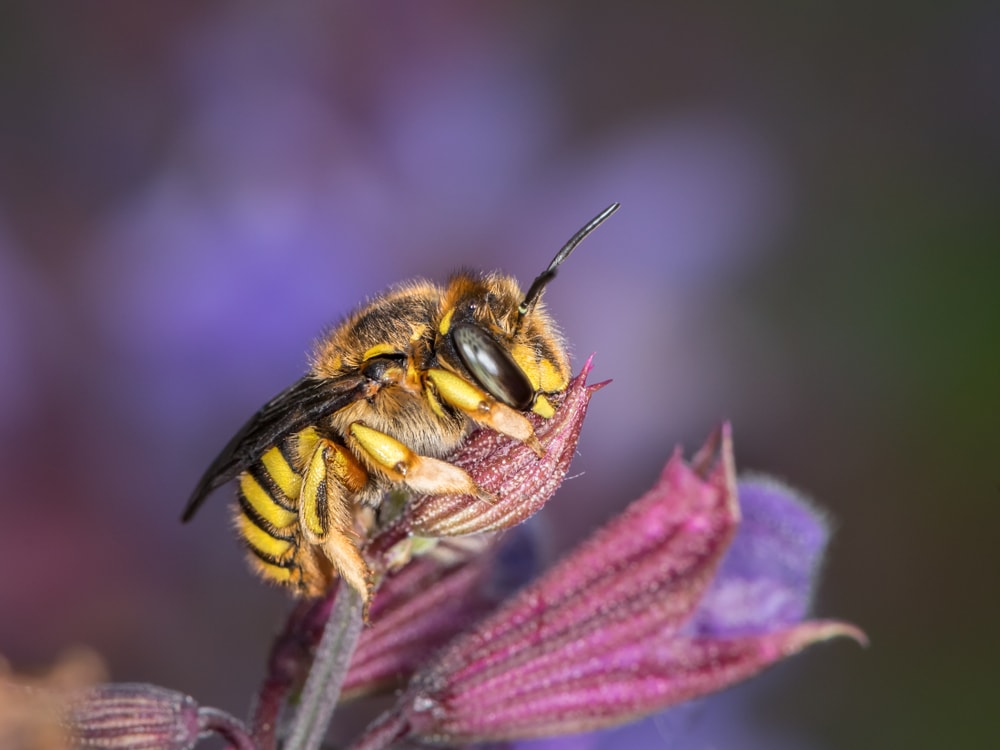
In the wool carder, there are some variations in the coloring of its yellow markings. At first glance, some specimens could easily be mistaken for a wasp.
Lamb’s Ear is a favorite with wool carder bees, as the female gathers the hairy fibers from the plant for plugging the cells of her nest that she makes in wall cavities, hollow stems, or dead wood.
This species is native to Europe, western Asia, and northern Africa, but has expanded its range around the globe. It was accidentally introduced into the US and first recorded near Ithaca, New York, in 1963. It eventually expanded its range to Nova Scotia and parts of Utah.
13. Flower Bee (Anthophora plumipes)
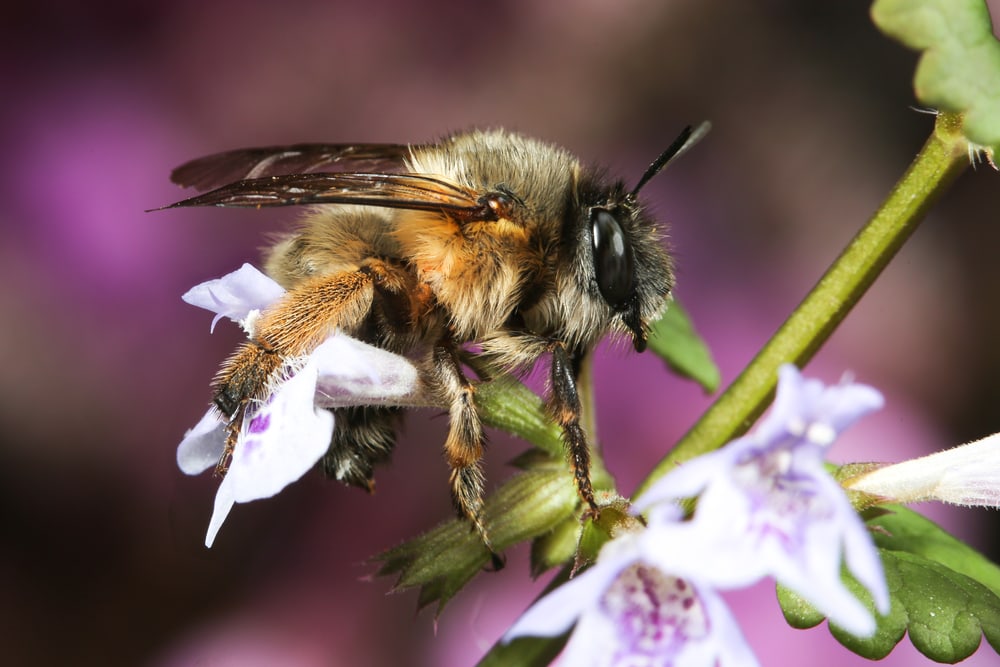
Flower bees, commonly referred to as hairy-footed flower bees, are a type of bumble bee. The male has long hairs on the lower parts of the middle legs, especially near the feet. Males are orange and the female all-black.
They are found throughout Britain and most of England and Wales, but more common in the south and east. Increasing records from northern England and some parts of southern and central Scotland.
14. Nomad Bee (Nomada)
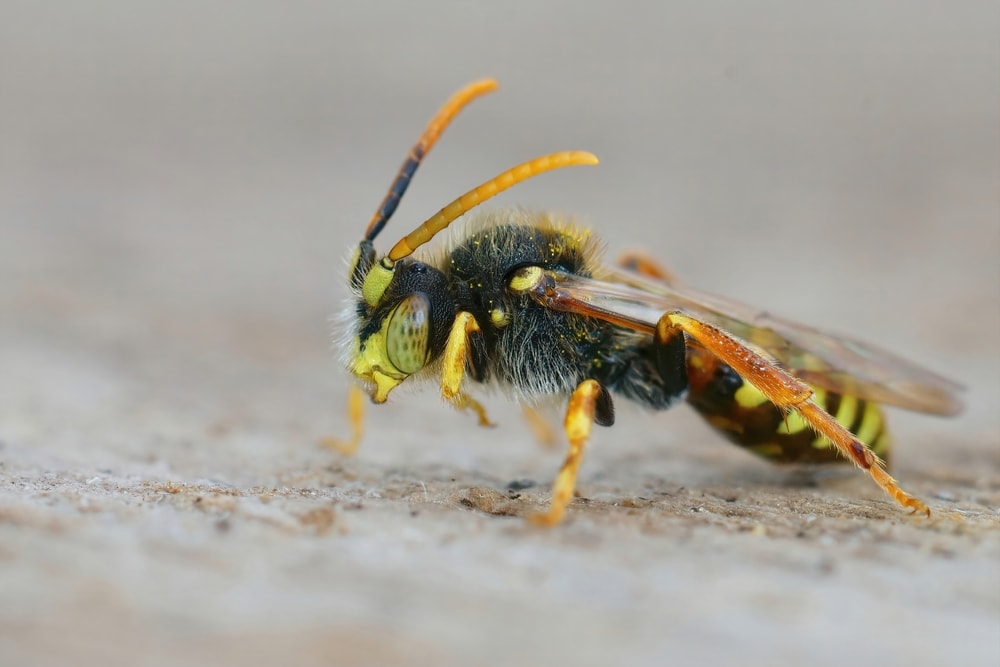
Nomad bees can easily be mistaken for small wasps. They are often red or red and black and often with yellow integumental markings. Others are yellow and black or have white markings instead of yellow. Females have specialized hair patches at the tip of their abdomen whereas males have a conspicuous pygidial plate, often notched.
This species is found over much of the world. Nomad bees are kleptoparasites, which means that their offspring will steal the cache of food supplies that the host left for her larvae. The first nomad bee egg that hatches dispatches its siblings before it eats the food supply and then kills and eats the host larva.
15. Long-horned Bee (Eucera longicornis)
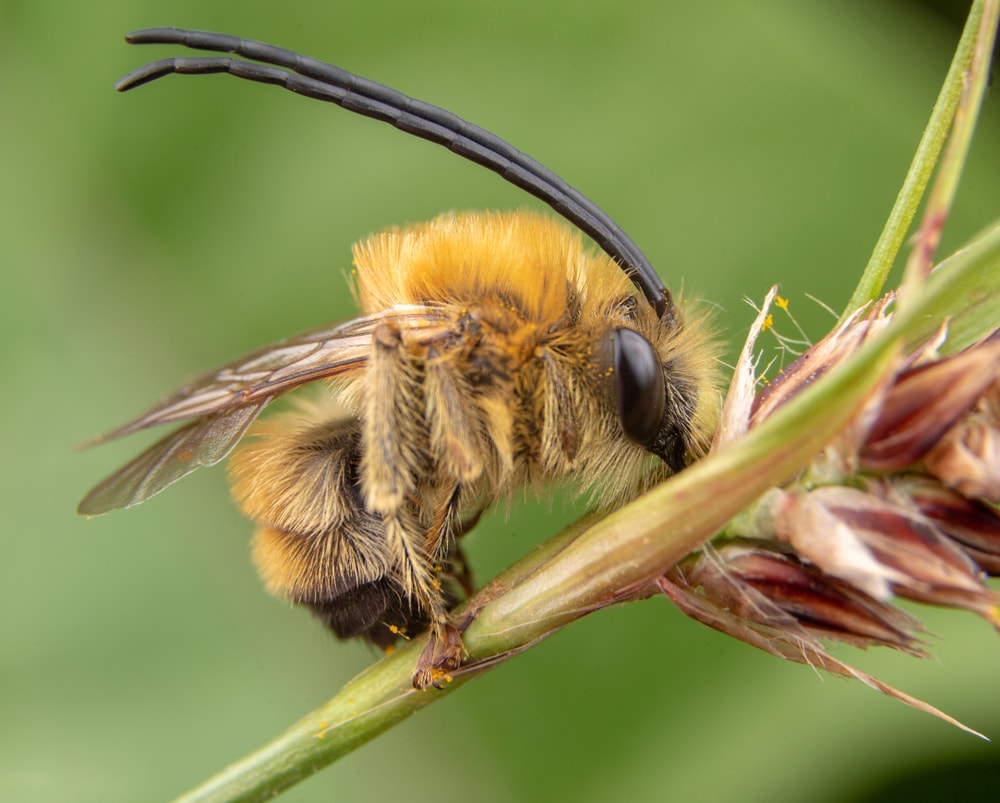
In the family of long-horned bees, only the males have long horns. Their thoraxes are covered with light brown hair, and their abdomens are also sparsely covered with light brown-haired. Their hair can fade to a silvery-white when exposed to the sun.
Females are similar to males, with shorter antennae, and a bit of a sturdier, more robust frame. They can be confused with some Flower bees.
They are now mostly found in a small number of locations on the south coasts of England and Wales with some inland populations near Shropshire.
16. Furrow Bee (Halictus rubicundus)
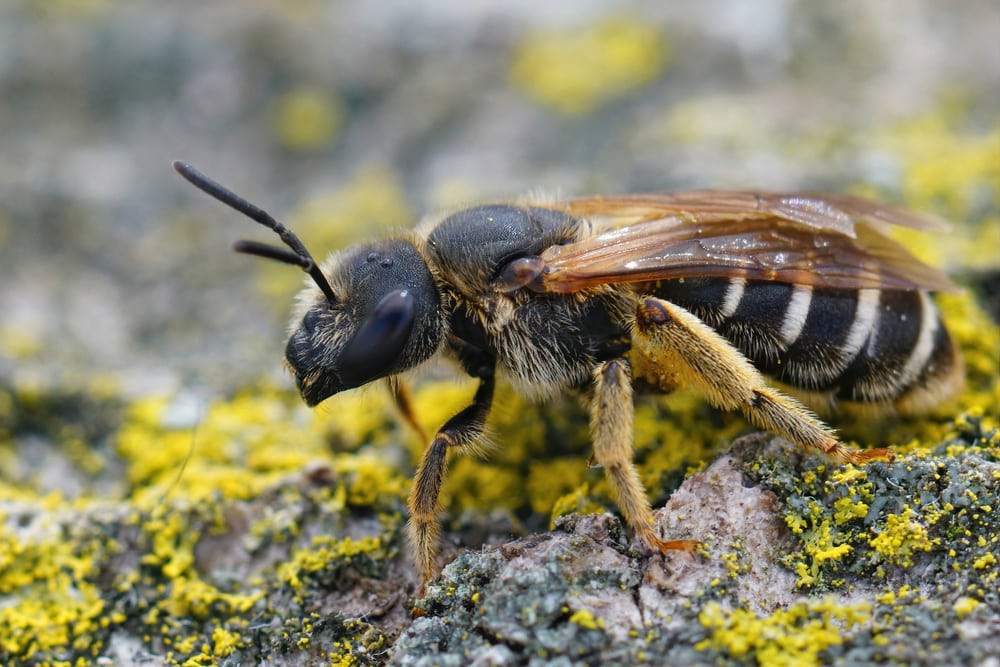
The most common furrow bee is the orange-legged furrow bee and can measure up to 10mm in length. In males, the body is proportionately longer and thinner than is the case with females. The pale stripes on the abdomen of the female are well defined. Generally, males have pale legs.
If you live in or travel to the United States, Canada, Europe, and northern Asia keep an eye out for this beautiful bee.
You May Also Like: Discover These 29 Different Types of Butterflies and Their Life Cycle with Photos, Infographics, Facts, and more!
What Do Bees Eat?
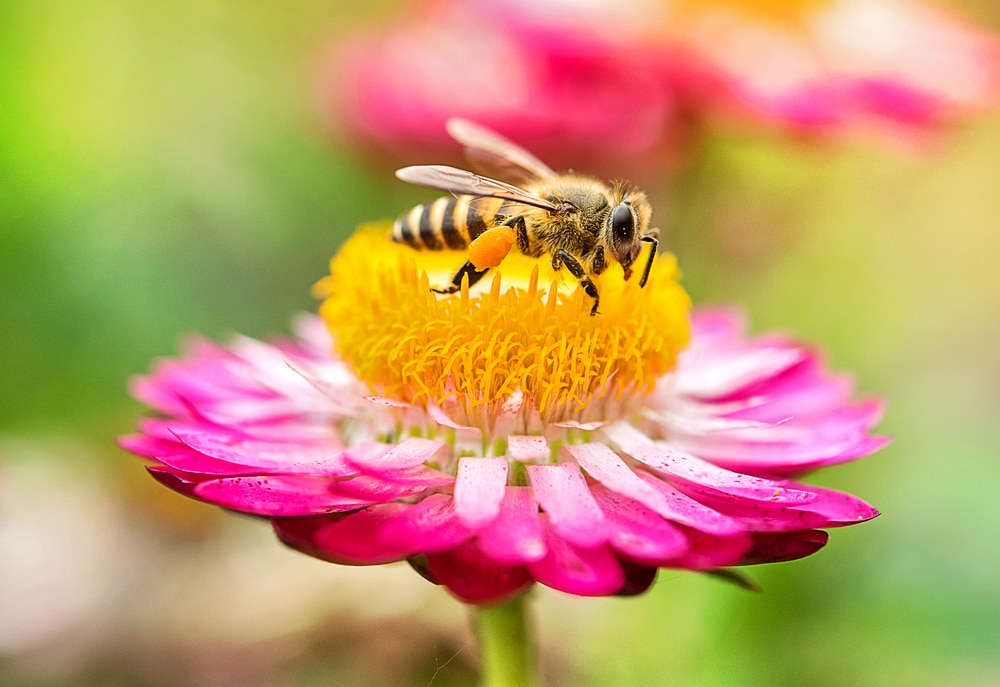
Most bees eat pollen and nectar. Worker bees gather both from flowers to feed to the larvae and other members of the colony. Because of their nectary sweetness, don’t be surprised or alarmed if you witness a bee enjoying a fruity delight.
How Do Bees Make Honey?
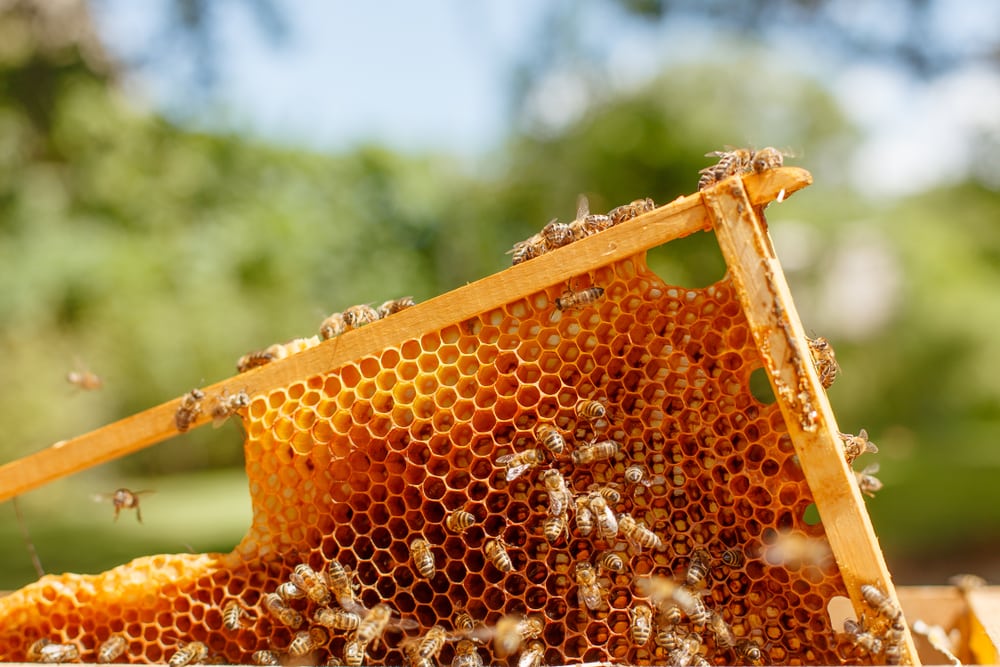
Most bees gather only pollen or nectar. As the nectar is sucked from the flower, it is stored in a special honey stomach ready to be transferred to the honey-making bees in the hive. If hungry the bee opens a valve in the nectar “sac” and a portion of the payload passes through to her stomach to be converted to energy for her own needs.
It can carry a payload of nectar or pollen close to her weight. When her nectar “sacs” are full, the honey bee returns to the hive. Nectar is delivered to one of the indoor bees and is then passed mouth-to-mouth from bee to bee until its moisture content is reduced from about 70% to 20%. This changes the nectar into honey.
Sometimes the nectar is stored at once in cells in the honeycomb before the mouth-to-mouth working because some evaporation is caused by the temperature inside the hive. The honey is then placed in storage cells and capped with beeswax in readiness for the arrival of newborn baby bees.
Why Do Bees Make Honey?
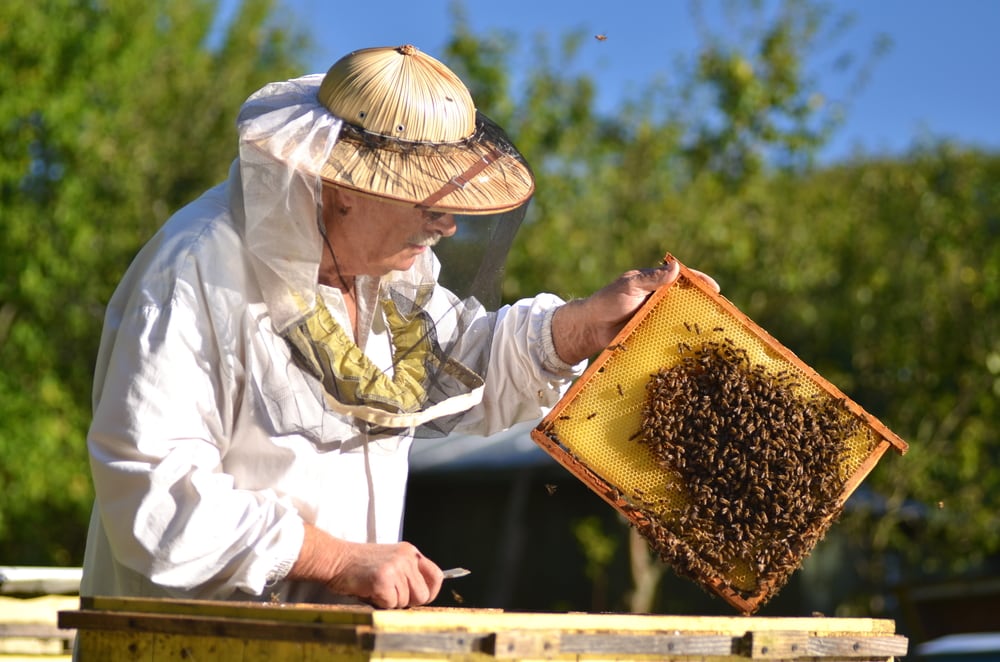
Honey bees make honey to store up as food to last them through the winter months. During the coldest time of year, there are fewer flowers from which to collect nectar, and honey bees are unable to forage.
Thanks to their supply of honey, members of these colonies survive through the winter, unlike in most bumblebee colonies where only the queen bee survives by hibernating underground.
How Long Do Bees Live?
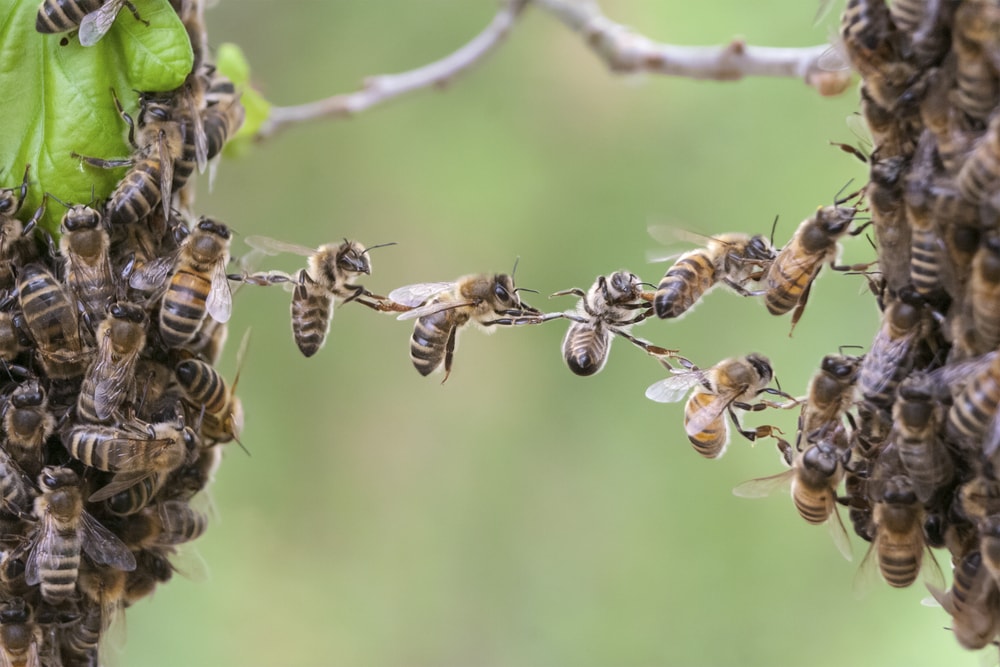
The lifespan of a bee depends on the type of bee, the role of the bee within the colony, factors such as weather, availability of forage, human intervention, and use of insecticides as well as the prevalence of diseases and parasites.
Honey bee workers live roughly 6-7 weeks when born in the Spring or Summer, and those born during autumn can live 4-6 months. The queen generally lives 3-6 years and the drones about 55 days.
Queen bumble bees live about a year while her workers and males live between two weeks and six weeks.
Solitary bees have been known to live for about a year.
Do Bees Migrate?
Some bees are not able to live all year in one ecosystem because of changes in seasons or lack of available food. They either die or hibernate, by slowing down their systems.
Bee species do not migrate during the winter. Instead, they hibernate. An exception is non-native honey bees, which do not hibernate. They keep the hive warm by forming a “winter cluster,” which means they all huddle together and shiver to provide warmth
Why Are Bees Important?

To be able to feed the world’s growing population, we need more and more food, which must be diverse, balanced, and of good quality to ensure the progress and well-being of humankind.
Bees are renowned for their role in providing high-quality food (honey, royal jelly, and pollen) and other products used in healthcare and other sectors (beeswax, propolis, honey bee venom). But the work of bees entails much more!
The greatest contribution of bees and other pollinators is the pollination of nearly three-quarters of the plants that produce 90% of the world’s food. A third of the world’s food production depends on bees. Every third spoonful of food depends on pollination.
Do Bumble Bees Sting?
Bumblebees rarely sting. The chance of being stung by a bumblebee can be reduced by avoiding provoking them or making them aggressive.
How To Treat a Bee Sting?
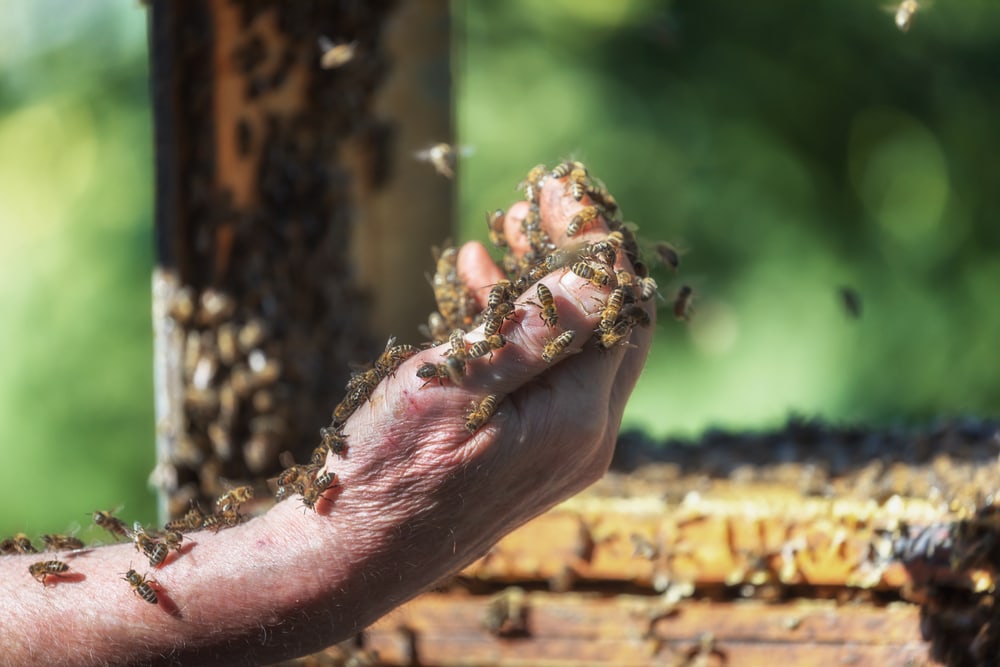
For minor reactions, remove the stinger, if you can, as soon as possible. You can scrape it off with a fingernail. Don’t try to remove a stinger below the skin surface. A stinger may not be present. Wash the sting area with soap and water, and apply a cold compress.
For moderate reactions, if you can, remove the stinger as soon as possible. You can scrape it off with a fingernail. Don’t try to remove a stinger below the skin surface. Once removed, wash the affected area with soap and water, and apply a cold compress.
Take an over-the-counter pain reliever as needed to help ease any discomfort. If the sting is on an arm or leg, elevate it. Apply hydrocortisone cream or calamine lotion to ease redness, itching, or swelling.
If itching or swelling is bothersome, take an oral antihistamine that contains diphenhydramine (Benadryl) or chlorpheniramine. Avoid scratching the sting area. This will worsen itching and swelling and increase your risk of infection.
For allergic reactions or an anaphylactic attack, an emergency medical team may perform cardiopulmonary resuscitation (CPR) if you stop breathing or your heart stops beating. You may be given medications to reduce your body’s allergic response.
If you do not seek or need emergency treatment, consult your doctor. He or she may refer you to an allergy specialist (allergist) who can determine whether you’re allergic to bees or other insect venom and can help you find ways to prevent future allergic reactions.
What Does a Queen Bee Do?

The queen’s two primary purposes are to produce chemical scents that help regulate the unity of the colony and to lay lots of eggs. The queen bee is the only female with fully developed ovaries.
The worker bees choose up to twenty of the fertilized eggs, seemingly at random, to be potential new queens. When these eggs hatch, the workers feed the larvae a special food called royal jelly. The first larvae to mature will become the new queen.
It is the responsibility of the queen to lay enough fertilized eggs to produce a well-developed force of worker bees for the colony. A very tall order for such a small specimen.
Bee Conservation
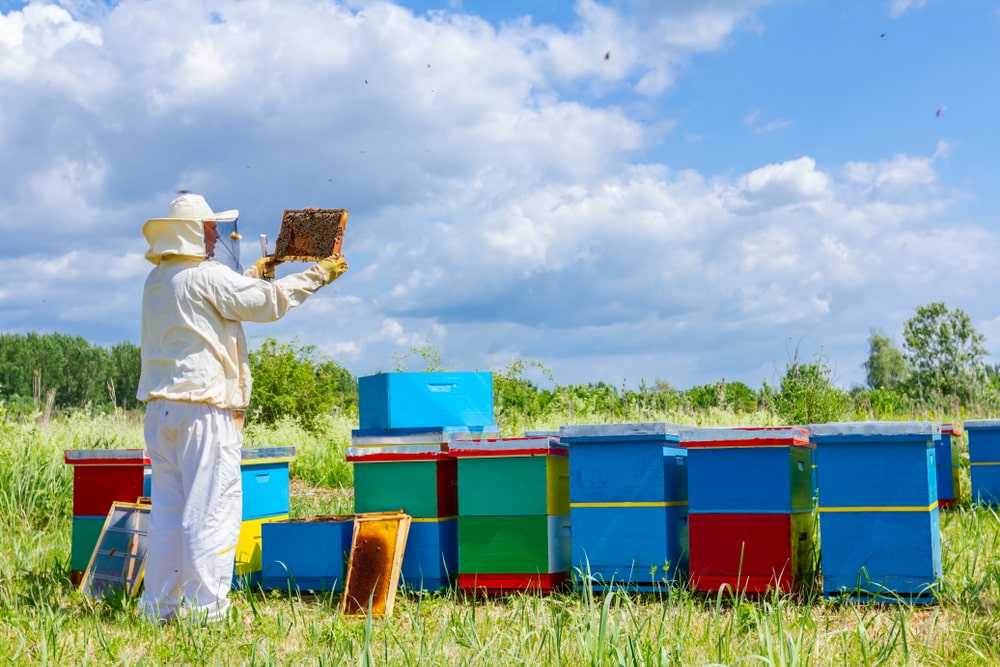
Both domesticated honey bees and many native bee species are in decline. Some species, such as the once-common rusty patched bumblebee, are now listed as endangered in the U.S.
Potential causes of these declines include habitat destruction, disease, agricultural and lawn and garden practices, use of pesticides, habitat fragmentation, changes in land use, invasive species, and climate change.
Pollinators, notably native bees, are critical to the survival of North America’s native plants, other wildlife, and people alike.
Climate Change and Threats to Different Types of Bees
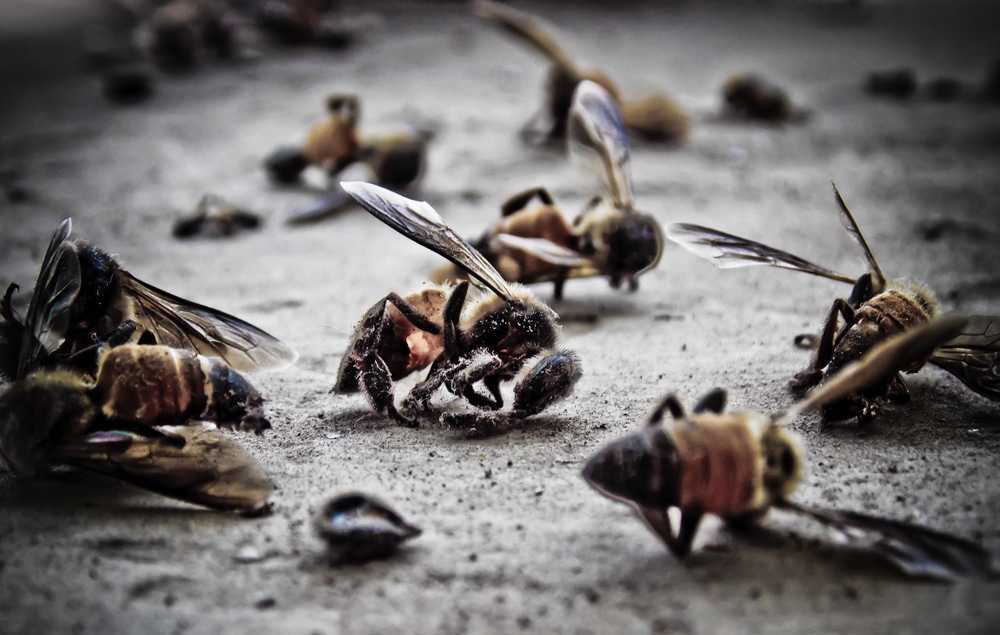
Climate change is causing temperature shifts which are leaving bees unable to pollinate in time. Bees are severely vulnerable to extreme weather and climate change has caused flowers to emerge and bloom earlier.
Because bees are unable to adapt to the changing climate, they are unable to pollinate flowers and, thus, do not obtain nectar for their hives to use during the harsh winter months. Many of these factors have combined to stimulate the spread of Colony Collapse Disorder (CCD).
CCD is a phenomenon where many worker bees in a colony disappear. This is a massive threat to bee populations. Research from the Environment Protection Agency shows that CCD is linked to changes in bee habitats and malnutrition, both of which are indirectly caused by climate change.
In addition to climate change, habitat loss, invasive plants, low genetic diversity, pathogens spread by commercially managed bees, and pesticides cause further decline in bee populations.
Ways to Help Bee Species
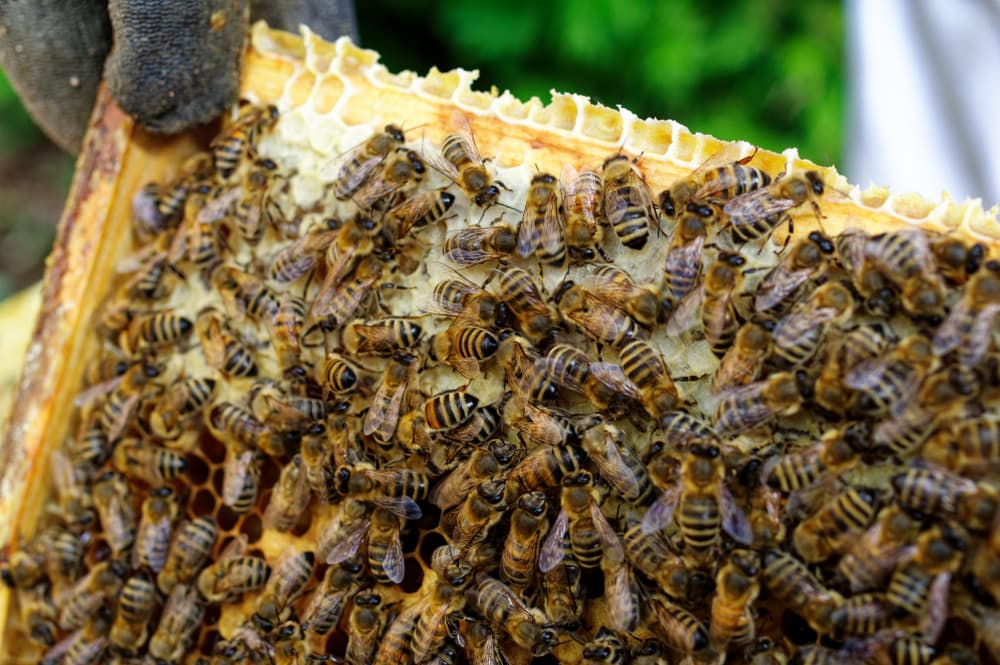
Bee populations are critical for ensuring a healthy environment. Here is a small list of things you can do to help secure the future of these amazing pollinators.
You May Also Like: The Different Types of Stink Bugs You Should Know About with Photos, Infographics, Facts, and more!
Cultural Symbolism of Bees
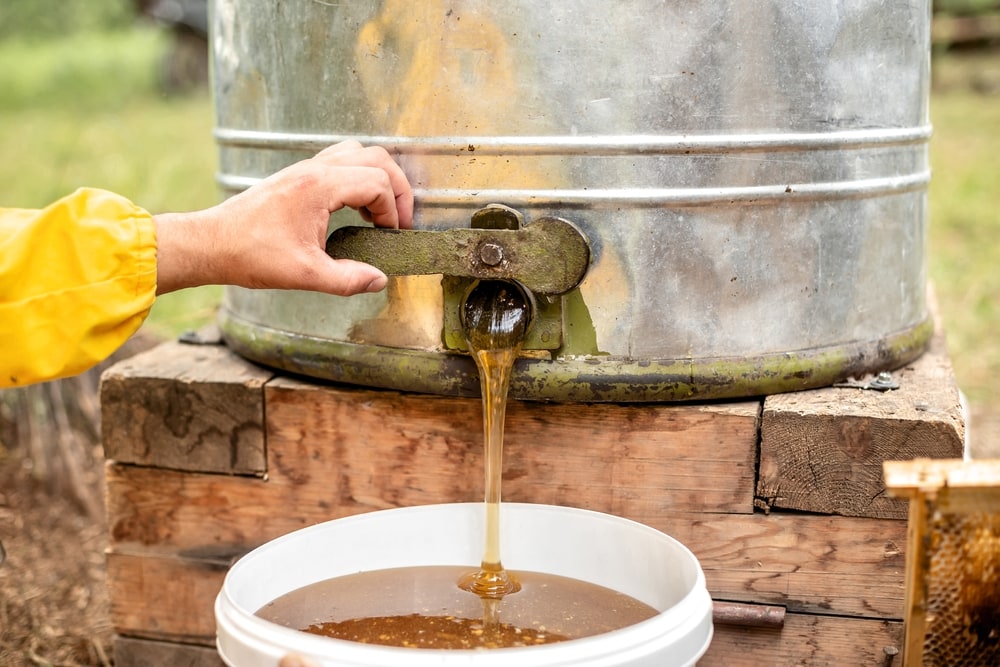
The bee icon is a symbol for manifesting things, including fertility, health and vitality, and prosperity. It’s also a good luck totem for being productive in your work and finding work that is fulfilling.
Bees have cultural and environmental importance as pollinators and producers of honey and medicinal products. The movement of pollen between plants is necessary for plants to fertilize and reproduce.
Both farmed and wild bees control the growth and quality of vegetation. An incredible feat considering their size. When they thrive, the crops thrive, and our planet survives.








